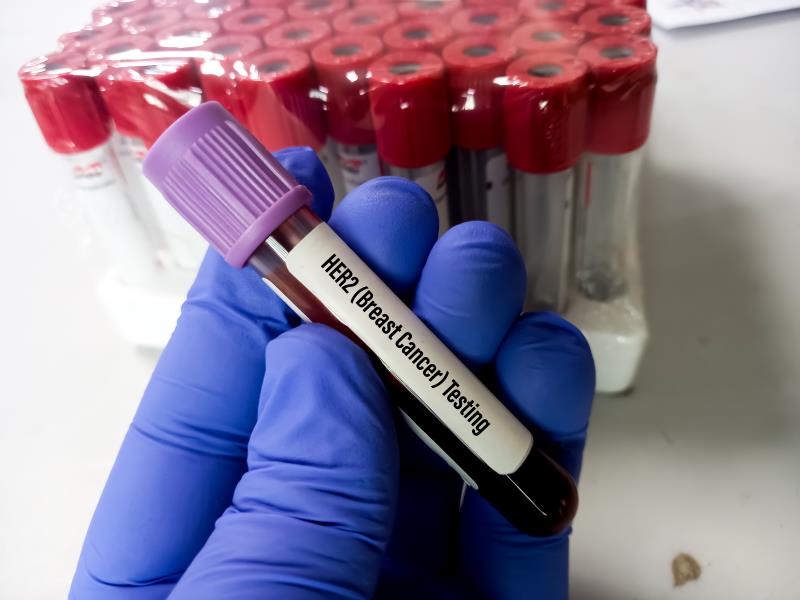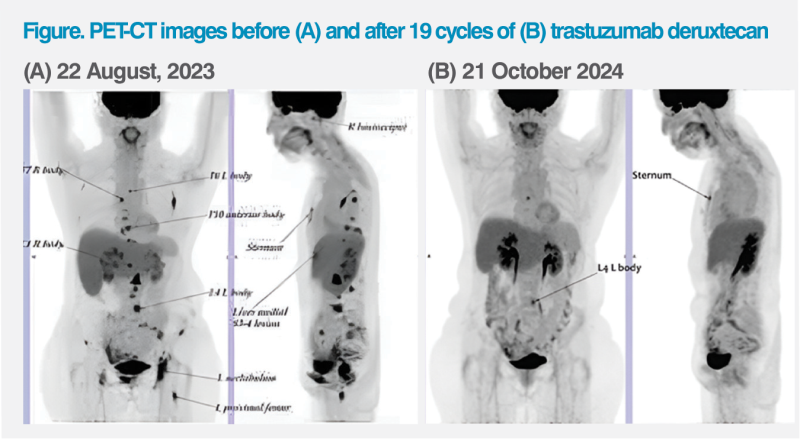Second-line antibody-drug conjugate in a patient with HR-positive, HER2-low advanced breast cancer





History, initial treatments and response
A 56-year-old woman who is a smoker with a history of endometriotic cyst and no family history of cancers was diagnosed in 2015 with T2N1, hormone receptor (HR)–positive, HER2-negative right breast cancer. Baseline PET-CT scan showed suspicious bone metastasis at T2, which was unconfirmed histologically. She was premenopausal at diagnosis with an Eastern Cooperative Oncology Group performance status (PS) of 0.
The patient completed six cycles of neoadjuvant doxorubicin and cyclophosphamide, followed by a modified radical mastectomy in July 2015. Postoperative PET-CT showed resolution of the T2 lesion. She then received adjuvant paclitaxel and locoregional radiotherapy. Tamoxifen was started in January 2016. Total hysterectomy with bilateral salpingo-oophorectomy was performed in March 2018 for endometriotic cyst and fibroids, after which the patient was switched to letrozole from October 2018 to July 2021.
Subsequent treatments and response
In July 2021, the patient complained of lower limb weakness and bone pain. She was unable to walk and had a PS of 2. MRI revealed diffuse bone metastases in the spine, sacrum and iliac bone, and a compression fracture at T2 with cord compression. Rebiospy during emergency spinal decompression/fusion surgery found HR-positive, HER2-low (HER2 score of 2 and negative HER2 fluorescence in situ hybridization [FISH] test) metastatic breast cancer (mBC). Restaging PET-CT showed diffuse bone involvement and liver metastasis measuring 1.4 cm. She subsequently received radiation therapy to the cervical and thoracic spine. Denosumab was started in December 2021 to prevent skeletal-related events secondary to bone metastases.
From December 2021 to April 2023, the patient received two endocrine therapy regimens: first with fulvestrant and palbociclib, then on progression, with fulvestrant and alpelisib as PIK3CA mutation was detected. PET-CT in April 2023 showed mixed response with multiple active bone metastases.
In June 2023, the patient was started on single-agent chemotherapy with capecitabine but showed no response after four cycles. Tumour marker levels continued to increase. PET-CT scan in August 2023 showed progression of liver and bone lesions, while CA15-3 and CEA levels rose to 162 U/mL and 157 ng/mL, respectively. (Figure 1A)

In early September 2023, the patient was started on the antibody-drug conjugate (ADC), trastuzumab deruxtecan (T-DXd), at 5.4 mg/kg Q3W (295 mg). She experienced early and sustained response, with CA15-3 levels decreasing to 156 U/mL and CEA level decreasing to 131 ng/mL after one cycle, and further to 139 U/mL and 46 ng/mL, respectively, after five cycles.
The patient continued to respond well to T-DXd. PET-CT in January 2024 showed good partial response with improving liver and bone metastases. Although her PS remained 1 and she still required a cane to walk, her bone pain gradually resolved, allowing her to enjoy a good quality of life (QoL). She also gained weight, prompting an increase of T-DXd dose to 325 mg (in order to maintain the dosage at 5.4 mg/kg) in July 2024.
Reassessment PET-CT done in late October 2024 showed mixed response with improvement of remaining hypermetabolic bone metastases but interval deterioration of the lesions at L4 and the sternum. (Figure 1B) Further management was under discussion at the time of writing. Meanwhile, her tumour markers continued to decrease, with CA15-3 and CEA levels at 32 U/mL and 6.5 ng/ mL, respectively, on 10 October 2024.
The patient tolerated T-DXd well throughout the course of treatment and did not experience any cardiac-related adverse events (AEs) or interstitial lung disease (ILD). The only AEs she experienced were mild nausea, which was adequately managed with netupitant/palonosetron, and mild alopecia. No dose adjustments were needed for T-DXd.
Discussion
About 60 percent of patients who are classified as having HER2- negative BC actually exhibit low HER2 expression (ie, an immunohistochemistry score of 1+, or a score of 2+ alongside negative in situ hybridization results).1,2 Previously, HER2-low BC was treated as HER2-negative disease, with limited treatment options after failing endocrine-based therapies.3,4
Since the phase III randomized DESTINY-Breast04 trial showed significantly improved survival with T-DXd vs chemotherapy in HER2-low mBC, regardless of HR status,4 T-DXd was approved for second-line treatment in adults with unresectable or HER2-low mBC who received prior chemotherapy or experienced recurrence during or within 6 months of completing adjuvant chemotherapy.4-6
DESTINY-Breast04 enrolled 557 patients with HER2-low mBC who received 1–2 prior lines of chemotherapy or experienced recurrence ≤6 months after adjuvant chemotherapy. Patients received either T-DXd or physician’s choice of chemotherapy. The primary endpoint was progression-free survival (PFS) in the HR-positive cohort, and key secondary endpoints included overall survival (OS) and PFS for all patients.4
In the HR-positive cohort, median PFS was 10.1 vs 5.4 months with T-Dxd vs chemotherapy (hazard ratio, 0.51; 95 percent confidence interval [CI], 0.40– 0.64; p<0.001), while median OS was 23.9 vs 17.5 months (hazard ratio, 0.64; 95 percent CI, 0.48–0.86; p=0.003). Significantly improved median PFS and OS were also observed with T-DXd vs chemotherapy among all patients regardless of HR status.4
Similarly, the above patient had been on T-DXd for >1 year with good disease control. From the author’s clinical experience, a significant proportion of patients with HER2-low mBC on T-DXd can achieve a PFS similar to that reported in DESTINY-Breast04.4
In DESTINY-Breast04, T-DXd was also associated with superior objective response rates (ORRs) vs chemotherapy in the HR-positive cohort (confirmed ORR, 52.6 vs 16.3 percent) and in all patients regardless of HR status.4
In the author’s clinical practice, early and prolonged response to T-DXd has been observed. Tumour markers tend to drop after 1–2 treatment cycles, with concordant responses seen in imaging studies.
T-DXd is well tolerated in author’s clinical practice, with ILD occurring in <10 percent of patients (12.1 percent in DESTINY-Breast04), which is often grade 1 and can be managed by giving corticosteroids along with temporarily withholding treatment. In more than half of the patients, treatment could be resumed after appropriate ILD management.4,5,7,8 Among other AEs, nausea, such as that experienced by our patient, can be effectively managed with antiemetics.5
When initiating T-DXd for HER2-low mBC, it is crucial to administer the recommended dose of 5.4 mg/kg Q3W, at the right time.5 Lower doses may lead to inadequate responses or shorter duration of response, which have been seen in clinical practice. As an ADC, T-DXd’s highly membrane-permeable payload enables a potent bystander effect, exerting cytotoxic effects on neighbouring tumour cells, regardless of target expression.9
Although T-DXd can be initiated at any time, starting it as soon as possible, preferably after one line of chemotherapy, would be beneficial to patients in terms of treatment efficacy and QoL, given its early and superior response vs chemotherapy and acceptable safety profile demonstrated in DESTINY-Breast04, and as observed in our patient.4
Most patients with HER2-low mBC and PS ≤2 are suitable candidates for T-DXd unless contraindicated. Caution is advised for those with a history of ILD, cardiac problems, or symptomatic brain metastases.5
In summary, the positive outcome seen in our patient and the results of DESTINY-Breast04 highlight the importance of accurately determining HER2 status to identify mBC patients who may benefit from T-DXd treatment.